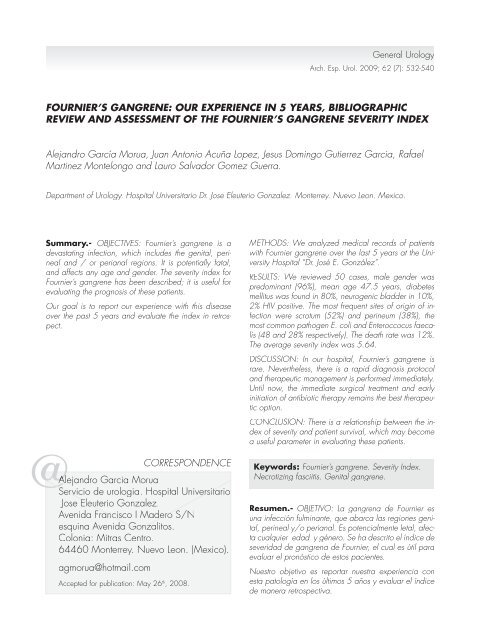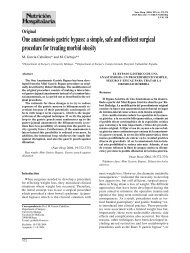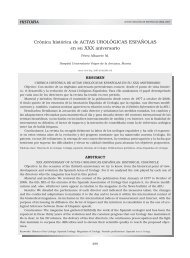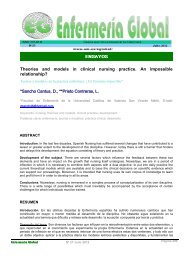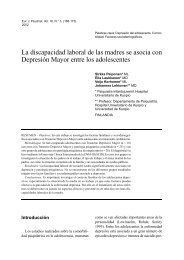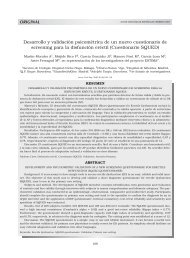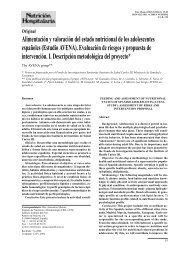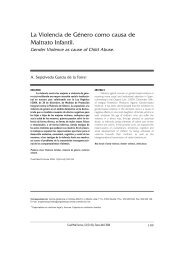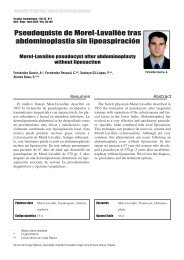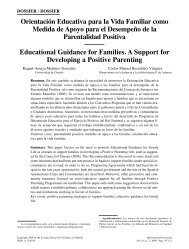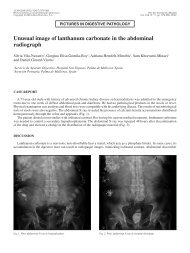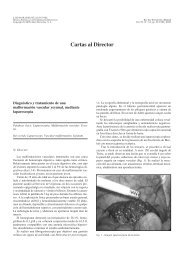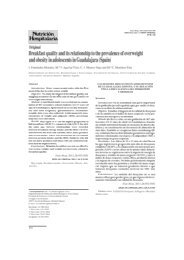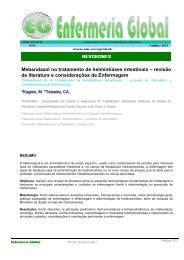fournier's gangrene: our experience in 5 years, bibliographic
fournier's gangrene: our experience in 5 years, bibliographic
fournier's gangrene: our experience in 5 years, bibliographic
You also want an ePaper? Increase the reach of your titles
YUMPU automatically turns print PDFs into web optimized ePapers that Google loves.
General Urology<br />
FOURNIER’S GANGRENE: OUR EXPERIENCE IN 5 YEARS, BIBLIOGRAPHIC<br />
REVIEW AND ASSESSMENT OF THE FOURNIER’S GANGRENE SEVERITY INDEX<br />
Alejandro García Morua, Juan Antonio Acuña Lopez, Jesus Dom<strong>in</strong>go Gutierrez Garcia, Rafael<br />
Mart<strong>in</strong>ez Montelongo and Lauro Salvador Gomez Guerra.<br />
Department of Urolog y. y Hospital Universitario Dr. Jose Eleuterio Gonzalez. Monterrey. Nuevo Leon. Mexico.<br />
Summary.- OBJECTIVES: F<strong>our</strong>nier’s <strong>gangrene</strong> is a<br />
devastat<strong>in</strong>g <strong>in</strong>fection, which <strong>in</strong>cludes the genital, per<strong>in</strong>eal<br />
and / or perianal regions. It is potentially fatal,<br />
and affects any age and gender. The severity <strong>in</strong>dex for<br />
F<strong>our</strong>nier’s <strong>gangrene</strong> has been described; it is useful for<br />
evaluat<strong>in</strong>g the prognosis of these patients.<br />
Our goal is to report <strong>our</strong> <strong>experience</strong> with this disease<br />
over the past 5 <strong>years</strong> and evaluate the <strong>in</strong>dex <strong>in</strong> retrospect.<br />
@Alejandro Garcia Morua<br />
CORRESPONDENCE<br />
@Alejandro<br />
@Servicio<br />
@Servicio<br />
@Servicio<br />
Garcia Morua<br />
de de urologia<br />
urologia. Hospital Universitario<br />
Jose Eleuterio Gonzalez.<br />
Avenida Francisco I Madero S/N<br />
esqu<strong>in</strong>a Avenida Gonzalitos.<br />
Colonia: Mitras Centro.<br />
64460 Monterrey. Nuevo Leon. (Mexico).<br />
agmorua@hotmail.com<br />
Accepted for publication: May 26 th , 2008.<br />
Arch. Esp. Urol. 2009; 62 (7): 532-540<br />
METHODS: We analyzed medical records of patients<br />
with F<strong>our</strong>nier <strong>gangrene</strong> over the last 5 <strong>years</strong> at the University<br />
Hospital “Dr. José E. González”.<br />
RESULTS: We reviewed 50 cases, male gender was<br />
predom<strong>in</strong>ant (96%), mean age 47.5 <strong>years</strong>, diabetes<br />
mellitus was found <strong>in</strong> 80%, neurogenic bladder <strong>in</strong> 10%,<br />
2% HIV positive. The most frequent sites of orig<strong>in</strong> of <strong>in</strong>fection<br />
were scrotum (52%) and per<strong>in</strong>eum (38%), the<br />
most common pathogen E. coli and Enteroccocus faecalis<br />
(48 and 28% respectively). The death rate was 12%.<br />
The average severity <strong>in</strong>dex was 5.64.<br />
DISCUSSION: In <strong>our</strong> hospital, F<strong>our</strong>nier’s <strong>gangrene</strong> is<br />
rare. Nevertheless, there is a rapid diagnosis protocol<br />
and therapeutic management is performed immediately.<br />
Until now, the immediate surgical treatment and early<br />
<strong>in</strong>itiation of antibiotic therapy rema<strong>in</strong>s the best therapeutic<br />
option.<br />
CONCLUSION: There is a relationship between the <strong>in</strong>dex<br />
of severity and patient survival, which may become<br />
a useful parameter <strong>in</strong> evaluat<strong>in</strong>g these patients.<br />
Keywords: F<strong>our</strong>nier’s <strong>gangrene</strong>. Severity Index.<br />
Necrotiz<strong>in</strong>g fasciitis. Genital <strong>gangrene</strong>.<br />
Resumen.- OBJETIVO: La gangrena de F<strong>our</strong>nier es<br />
una <strong>in</strong>fección fulm<strong>in</strong>ante, que abarca las regiones genital,<br />
per<strong>in</strong>eal y/o perianal. Es potencialmente letal, afecta<br />
cualquier edad y género. Se ha descrito el índice de<br />
severidad de gangrena de F<strong>our</strong>nier, el cual es útil para<br />
evaluar el pronóstico de estos pacientes.<br />
Nuestro objetivo es reportar nuestra experiencia con<br />
esta patología en los últimos 5 años y evaluar el índice<br />
de manera retrospectiva.
MÉTODOS: Se analizaron los expedientes clínicos de<br />
los pacientes con gangrena de F<strong>our</strong>nier los últimos 5<br />
años en el Hospital Universitario “Dr. José E. González”.<br />
RESULTADOS: Se revisaron 50 expedientes, el género<br />
predom<strong>in</strong>ante fue el mascul<strong>in</strong>o (96%), la edad promedio<br />
47.5 años, se encontró diabetes mellitus en un 80%, vejiga<br />
neurogénica 10%, HIV positivo 2%. Los sitios de origen<br />
más frecuente de <strong>in</strong>fección fueron escroto (52%) y<br />
per<strong>in</strong>é (38%), los agentes patógenos más frecuentes E.<br />
coli y Enteroccocus faecalis (48 y 28% respectivamente).<br />
El porcentaje de defunción fue del 12%, el índice de<br />
severidad promedio fue 5.64.<br />
DISCUSIÓN: En nuestro Hospital, la gangrena de F<strong>our</strong>nier<br />
es una patología poco frecuente; a pesar de esto,<br />
se cuenta con un diagnóstico rápido y a su vez un manejo<br />
<strong>in</strong>mediato. Hasta el momento la conducta quirúrgica<br />
<strong>in</strong>mediata y el pronto <strong>in</strong>icio de antibioticoterapia<br />
cont<strong>in</strong>úan siendo la mejor opción terapéutica.<br />
CONCLUSIÓN: Existe una relación entre el índice de<br />
severidad y la sobrevida de los pacientes, lo cual puede<br />
convertirlo en un parámetro útil en la evaluación de<br />
estos pacientes.<br />
Palabras clave: Gangrena de F<strong>our</strong>nier. Indice<br />
de severidad. Fascitis necrotizante. Gangrena<br />
genital.<br />
INTRODUCTION<br />
F<strong>our</strong>nier’s <strong>gangrene</strong> is a fulm<strong>in</strong>ant <strong>in</strong>fection,<br />
<strong>in</strong>clud<strong>in</strong>g necrotiz<strong>in</strong>g fasciitis type regions genital, per<strong>in</strong>eal<br />
and / or perianal. This <strong>in</strong>fectious and necrotic<br />
sk<strong>in</strong> lesion, although it was <strong>in</strong>itially described by Baurienne<br />
<strong>in</strong> 1764 (1,3) is named after Jean Alfred F<strong>our</strong>nier,<br />
French dermatologist who <strong>in</strong> 1883 described a<br />
syndrome of unexpla<strong>in</strong>ed <strong>gangrene</strong> <strong>in</strong> the penis and<br />
scrotum <strong>in</strong> 5 young men with no other pathology basis<br />
of sudden onset and rapid progresion (2).<br />
This condition is potentially fatal, affects any<br />
age and gender, has been reported even <strong>in</strong> neonates<br />
(4), is characterized by rapid progression of <strong>in</strong>fection<br />
<strong>in</strong> soft tissue caused by the synergistic action<br />
of several agencies that extend along fascial planes,<br />
subfacial caus<strong>in</strong>g necrosis of these tissues and destruction<br />
(5). This necrosis is secondary to thrombosis<br />
of small vessels, which is due to endarteritis obliterans<br />
caused by the spread of microorganisms <strong>in</strong>to the subcutaneous<br />
space (platelet aggregation stimulated by<br />
hepar<strong>in</strong>asa produced by aerobic and anaerobic) (3),<br />
that <strong>in</strong> addition to generat<strong>in</strong>g local edema, hypoxia,<br />
diffi culty by local blood supply, which favors the deve-<br />
FOURNIER’S GANGRENE: OUR EXPERIENCE IN 5 YEARS...<br />
533<br />
lopment of anaerobic bacteria, these microorganisms<br />
produce hydrogen and nitrogen that accumulate <strong>in</strong><br />
tissues caus<strong>in</strong>g crepitation (5).<br />
Among the most frequent concomitant diseases<br />
are diabetes mellitus (present between 32 - 66%<br />
of cases) (6), alcoholism and cancer, among other<br />
immunosuppressive diseases.<br />
It is a situation that warrants urgent radical<br />
surgical treatment (debridement), <strong>in</strong> addition to the<br />
use of antibiotics apropiados (7). Mortality has been<br />
reported <strong>in</strong> different series, rang<strong>in</strong>g from 3 - 67% <strong>in</strong><br />
unas7 0 - 80% others (3).<br />
Its cl<strong>in</strong>ical presentation is variable but often<br />
does so with edema, erythema, pa<strong>in</strong>, fever and <strong>in</strong>creased<br />
volume, the crepitus is present <strong>in</strong> 50-62% of<br />
cases (3). The time <strong>in</strong>terval from onset of symptoms<br />
specifi c to the process until the request for medical<br />
care is from 2 to 7 days, on average. This time determ<strong>in</strong>es<br />
the extent of the necrotic area and a critical<br />
<strong>in</strong>fl uence on the prognosis (1). With<strong>in</strong> the imag<strong>in</strong>g<br />
studies of X-rays are useful <strong>in</strong> demonstrat<strong>in</strong>g the presence<br />
of gas <strong>in</strong> soft tissues, more useful is the ultrasound.<br />
who can demonstrate the presence of diffuse<br />
edema, thickness of the scrotal wall and possibly the<br />
penis and the presence of escrotal gas (3).<br />
Has been described <strong>gangrene</strong> severity <strong>in</strong>dex<br />
of F<strong>our</strong>nier (5,8) (Table I), which is useful for evaluat<strong>in</strong>g<br />
the prognosis of these patients.<br />
The management ranges from emergency<br />
surgery (debridement), manag<strong>in</strong>g topic (sodium<br />
hypochlorite, hydrogen superoxide and even honey),<br />
antibiotics, until hiperbaric oxygen (12,18).<br />
OBJECTIVE<br />
The purpose of this paper is to report <strong>our</strong> <strong>experience</strong><br />
over the past 5 <strong>years</strong> regard<strong>in</strong>g this disease<br />
and to assess retrospectively the rate of severity and<br />
to assess whether <strong>our</strong> results are comparable to those<br />
published.<br />
MATERIAL AND METHODS<br />
We analyzed medical records of patients admitted<br />
with a diagnosis of F<strong>our</strong>nier’s <strong>gangrene</strong> <strong>in</strong> a<br />
period from June 2002 to June 2007, at the University<br />
Hospital “Dr. Joseph E. Gonzalez. “<br />
The criteria used to establish the diagnosis<br />
were the anamnesis and physical exam<strong>in</strong>ation of
534<br />
patient records were <strong>in</strong>complete and excluded those<br />
who did not meet <strong>in</strong>clusion criteria.<br />
All patients required early surgical debridement<br />
and adm<strong>in</strong>istration of parenteral antibiotics for<br />
at least a double outl<strong>in</strong>e, this will change once the<br />
antibiograms obta<strong>in</strong>ed from samples sent to bacteriology.<br />
We analyzed <strong>in</strong> retrospect the cl<strong>in</strong>ical records<br />
of these patients, assess<strong>in</strong>g the age, gender,<br />
symptoms, physical exam<strong>in</strong>ation, laboratory tests on<br />
admission, surgical procedures performed, transfusion,<br />
pathogen isolation, antibiotic adm<strong>in</strong>istered and<br />
<strong>in</strong>dex of severity for this way to establish the criteria<br />
that could be very useful to evaluate these patients <strong>in</strong><br />
the emergency department to predict what the prognosis<br />
for each.<br />
RESULTS<br />
We obta<strong>in</strong>ed a total of 63 cases of patients<br />
with F<strong>our</strong>nier’s <strong>gangrene</strong> <strong>in</strong> this period of 5 <strong>years</strong>, of<br />
whom 13 were excluded for not fulfi ll<strong>in</strong>g the <strong>in</strong>clusion<br />
criteria. Of the 50 patients were reviewed, the male<br />
gender was predom<strong>in</strong>ant, with 48 men (96%) and<br />
2 (4%) women, mean age was 47.5 <strong>years</strong>, rang<strong>in</strong>g<br />
from 6 to 86 <strong>years</strong> (Figure 1) . Analyz<strong>in</strong>g pathological<br />
antecedents, we fi nd the presence of diabetes mellitus<br />
<strong>in</strong> most patients (80%) of whom 50% (25 patients)<br />
already had a diagnosis of DM2, with a diagnosis<br />
of DM1 (2%) and the diagnosis was performed <strong>in</strong> 14<br />
patients (28%), at the time of admission to the emergency<br />
adult, other personal pathological signifi cance<br />
neurogenic bladder were found <strong>in</strong> 5 patients (10%)<br />
and there was no history of importance <strong>in</strong> 6 patients<br />
(12%), only found one (2%) HIV positive. 48% had a<br />
history of smok<strong>in</strong>g and alcohol positive.<br />
The most common symptoms at the time of<br />
admission were attack the generally state (80%),<br />
scrotal volume <strong>in</strong>crease (84%), fever (74%), per<strong>in</strong>eal<br />
or genital pa<strong>in</strong> (68%) (Figure 2), the average time<br />
of symptoms prior to referral to treatment was 6.87<br />
days, rang<strong>in</strong>g between 2 - 15 days.<br />
With<strong>in</strong> the surgery procedures, debridement<br />
was performed at 100% of patients, cystotomy to<br />
32%, orchidectomy 18% and colostomy 10% (Figure<br />
3) were performed on average 1.68 operations<br />
per patient (range 1-5) transoperative bleed<strong>in</strong>g<br />
was evaluated and documented between 100 and<br />
2000cc, with an average of 496cc, was evaluated<br />
as the time <strong>in</strong> the fi rst surgical <strong>in</strong>tervention be<strong>in</strong>g<br />
between 30 and 360 m<strong>in</strong>utes with an average of<br />
122.4 m<strong>in</strong>utes.<br />
A. García Morúa, J. A. Acuña López, J. D. Gutiérrez García et al.<br />
The most common site of orig<strong>in</strong> of <strong>in</strong>fection<br />
was 52% <strong>in</strong> the scrotum, followed by perianal <strong>in</strong> 38%<br />
(Figure 4), it is strik<strong>in</strong>g that <strong>in</strong> the patients who died<br />
perianal orig<strong>in</strong> was the most frequent followed by<br />
urethral. The most frequent pathogens were E. coli<br />
and Enteroccocus faecalis (48 and 28% respectively)<br />
(Table III), 58% of patients had <strong>in</strong>fections polibacterianas,<br />
14% monobacterianas and 6% of cases the<br />
culture was negative <strong>in</strong> 22% was not found cultivation.<br />
The antibiotics scheme most commonly used was<br />
Ofl oxac<strong>in</strong> 400mg IV every 12hrs plus cl<strong>in</strong>damyc<strong>in</strong><br />
600 mg IV every 6hrs, which was modifi ed accord<strong>in</strong>g<br />
to the antibiogram results. And if it changed was<br />
added a third-generation cephalospor<strong>in</strong>.<br />
14 patients (28%) required <strong>in</strong>tensive care<br />
unit stay there for an average of 7 days, the average<br />
hospital stay was 23.76 days (range 15 hrs to 95<br />
days). The death rate was 12% (6 patients) (Table<br />
II), the severity <strong>in</strong>dex calculated ranged from 0 - 14<br />
(average 5.64).<br />
DISCUSSION<br />
F<strong>our</strong>nier’s <strong>gangrene</strong> is a necrotiz<strong>in</strong>g fasciitis<br />
of soft tissues of the scrotum and per<strong>in</strong>eum of very<br />
rapid evolution can affect both men and women and<br />
usually patients have concomitant risk factors (2,14)<br />
60 <strong>years</strong><br />
FIGURE 1. Age groups.
Increase <strong>in</strong> scrotal volume<br />
General attack<br />
Fever<br />
Pa<strong>in</strong><br />
Headache<br />
Pruritus<br />
Nausea and vomit<strong>in</strong>g<br />
Secretion<br />
Sacral ulcer<br />
FIGURE 2.<br />
(Figure 4 and 5). Therefore we must consider it as a<br />
urological emergency because if not treated quickly<br />
mortality of this condition is usually very high (11).<br />
In its early F<strong>our</strong>nier’s <strong>gangrene</strong> was described as an<br />
Debridement<br />
Cystostomy<br />
Orchiectomy<br />
Colostomy<br />
Exploratory laparotomy<br />
Amputation<br />
Falectomia total<br />
FOURNIER’S GANGRENE: OUR EXPERIENCE IN 5 YEARS...<br />
535<br />
idiopathic entity, but <strong>in</strong> most cases a perianal <strong>in</strong>fection,<br />
ur<strong>in</strong>ary tract and local trauma or sk<strong>in</strong> condition<br />
at that level can be identifi ed (9), as noted <strong>in</strong> <strong>our</strong><br />
review most of the patients had <strong>in</strong>fection as the orig<strong>in</strong><br />
of the perianal area, scrotum, or urethra and others,<br />
there was none <strong>in</strong> which the orig<strong>in</strong> could not be identifi<br />
ed.<br />
The average age was 47.5 <strong>years</strong>, <strong>in</strong> most<br />
published series from 40.9 to 61.7 <strong>years</strong> (20), we<br />
present a range of 6 to 86 <strong>years</strong> (the child of 6 <strong>years</strong><br />
presented F<strong>our</strong>nier’s <strong>gangrene</strong> follow<strong>in</strong>g varicella <strong>in</strong>fection<br />
<strong>in</strong>volv<strong>in</strong>g the scrotum). It is important to emphasize<br />
these results because, as we see is a condition<br />
that is often present <strong>in</strong> patients of childbear<strong>in</strong>g<br />
age <strong>in</strong> particular, decreas<strong>in</strong>g at the extremes of life,<br />
for reasons that are not entirely clear but could be<br />
related with sexually active or simply with the activity<br />
of the patient.<br />
With regard to gender, the male predom<strong>in</strong>ance<br />
<strong>in</strong> 96%, so the female was present <strong>in</strong> 4%, which is<br />
reported <strong>in</strong> the literature is often a male, 10 times the<br />
female (20), <strong>in</strong> <strong>our</strong> <strong>experience</strong> this ratio was 26 times<br />
higher.<br />
At the onset of this pathology has been implicated<br />
<strong>in</strong> a number of factors, especially those that<br />
<strong>in</strong>volve or <strong>in</strong>terfere with the immune system, diabetes<br />
mellitus be<strong>in</strong>g the most frequently found co-morbid disease<br />
have been reported series where the frequency<br />
of this pathology <strong>in</strong> patients with F<strong>our</strong>nier’s <strong>gangrene</strong><br />
ranges from 55 to 70% (2,6) <strong>in</strong> the series that<br />
we present this fi gure is very similar <strong>in</strong> patients who<br />
Scrotum<br />
Perianal<br />
Urethral<br />
Ingu<strong>in</strong>al abscess<br />
FIGURE 3. FIGURE 4.
536<br />
were known diabetics (52%), but at the beg<strong>in</strong>n<strong>in</strong>g<br />
we found that 28% were unaware they were diabetic<br />
and diagnosed so far, which shows the role of uncontrolled<br />
diabetes mellitus <strong>in</strong> the pathogenesis of this<br />
disease, as 100% of patients were known diabetics<br />
who were not wear<strong>in</strong>g a proper control metabolism,<br />
the mean numbers of serum glucose of 268mg%. Of<br />
the 6 patients who died, 3 were known diabetics (one<br />
with fi gures of serum glucose to 784), 2 were not<br />
known diabetic and was diagnosed dur<strong>in</strong>g their stay<br />
<strong>in</strong> the <strong>in</strong>stitution and not the one suffer<strong>in</strong>g.<br />
Relationship was found between <strong>in</strong>creased<br />
mortality and duration of symptoms before hospitalization,<br />
the percentage of area <strong>in</strong>volved, and presence<br />
of serum BUN and creat<strong>in</strong><strong>in</strong>e hogh (15), we found<br />
that patients who died were on average 7.5 days of<br />
symptoms prior to their <strong>in</strong>come compared with 6.8<br />
days for those who survived, as well as BUN and<br />
serum creat<strong>in</strong><strong>in</strong>e higher <strong>in</strong> those who died compared<br />
with survivors (BUN 55.3 - 27.99 and Creat<strong>in</strong><strong>in</strong>e 2.7<br />
- 1.5 respectively).<br />
The most common sites are launched from the<br />
urethra (trauma, urolithiasis, catheterization, fi stulas,<br />
stenosis, massage or prostate biopsy), anorectal (perianal<br />
abscesses, fi ssures, hemorrhoids, carc<strong>in</strong>oma,<br />
appendicitis, diverticulitis, and perforation by foreign<br />
body), sk<strong>in</strong> <strong>in</strong>fections (<strong>in</strong>sertion of penile prosthesis,<br />
cauterization of warts, sk<strong>in</strong> abscesses) and <strong>in</strong> women<br />
(Barthol<strong>in</strong> abscess, vulvar, vulvar or per<strong>in</strong>eal wounds,<br />
episiotomy, hysterectomy, septic abortion, etc...)<br />
(3,5).<br />
No difference was found between the most<br />
common site of orig<strong>in</strong> <strong>in</strong> <strong>our</strong> series compared with<br />
those reported <strong>in</strong> the literature, these be<strong>in</strong>g the scrotum,<br />
perianal and urethral like these more frequent<br />
and the perianal the worst prognosis (12).<br />
This entity represents a polymicrobial <strong>in</strong>fection<br />
<strong>in</strong> most cases, so that both aerobic and anaerobic<br />
organisms may be present, although not all<br />
bacteria <strong>in</strong>volved can be identifi ed <strong>in</strong> cultures (23).<br />
Anaerobic bacteria are the least frequently isolated,<br />
and enterobacteria <strong>in</strong> turn are the most frequent and<br />
are usually found <strong>in</strong> particular E. coli, Bacteroides<br />
and streptococci, staphylococci, and Clostridium Peptoestreptococos<br />
have also been found.<br />
The aerobic bacteria caus<strong>in</strong>g platelet aggregation<br />
and an acceleration of coagulation by complement<br />
fi xation, while certa<strong>in</strong> anaerobes promote<br />
the formation of clots <strong>in</strong> a different way to produce a<br />
hepar<strong>in</strong>asa. These factors expla<strong>in</strong> the characteristic<br />
obliterated endarteritis with vascular thrombosis observed<br />
<strong>in</strong> this necrotiz<strong>in</strong>g fasciitis which is responsi-<br />
A. García Morúa, J. A. Acuña López, J. D. Gutiérrez García et al.<br />
ble for the subcutaneous tissue necrosis and <strong>gangrene</strong><br />
of the sk<strong>in</strong>. Bacteroides <strong>in</strong>hibit the phagocytosis<br />
of aerobic bacteria destruction. In this way, it is a<br />
destructive <strong>in</strong>fection of the comb<strong>in</strong>ation of relatively<br />
non-pathogenic organisms and the immune status of<br />
the patient.<br />
In <strong>our</strong> series, 58% of patients had polymicrobial<br />
<strong>in</strong>fection, and with<strong>in</strong> the most common pathogen<br />
E. coli, E. faecalis and Pseudomonas aerug<strong>in</strong>osa were<br />
the most frequent (48, 28 and 16% respectively), and<br />
it is also important to mention that 6% of patients<br />
with cultures of secretions were negative, most likely<br />
because it was not for cultivation or not anaerobic<br />
ask for fungi, although candida was found <strong>in</strong> 12% (6<br />
patients) of crops, which was considered rare as described<br />
Kazuyoshi and colleagues <strong>in</strong> 2000 to publish<br />
the report of a case of F<strong>our</strong>nier’s <strong>gangrene</strong> caused by<br />
Candida species as the primary microorganism (22)¸<br />
worth mention<strong>in</strong>g that 5 of these 6 patients (83.3%)<br />
were diabetic and one of them died.<br />
Cutaneous manifestations beg<strong>in</strong> with edema,<br />
erythema and local harden<strong>in</strong>g of the tissue surface<br />
areas later appear as echymosis and necrosis that<br />
often accompanied by crepitation and end of dra<strong>in</strong>age<br />
purulent material (2). Systemic manifestations are<br />
also quite varied and usually attack from the state, fever,<br />
to the presence of septic shock and usually these<br />
manifestations are related to the extent of necrosis. In<br />
<strong>our</strong> review there was no difference <strong>in</strong> the presence of<br />
these symptoms and necrot<strong>in</strong>g ulcer presented <strong>in</strong> 50%<br />
of patients, which is much higher than those reported<br />
<strong>in</strong> the literature that does not exceed 37.5% (2). With<br />
regard to laboratory fi nd<strong>in</strong>gs showed leukocytosis<br />
and the majority as mentioned <strong>in</strong> the review that we<br />
do <strong>in</strong> present<strong>in</strong>g septic shock thrombocytopenia can<br />
occur as a decrease <strong>in</strong> clott<strong>in</strong>g factors.<br />
Regard<strong>in</strong>g the management of these patients<br />
have been reported multiple behaviors, what is relevant<br />
is that <strong>in</strong> all situations is always recommended<br />
surgical management is more aggressive surgical debridement<br />
of the adm<strong>in</strong>istration of broad-spectrum antibiotic<br />
therapy, at least one double schema, or possibly<br />
a triple scheme depend<strong>in</strong>g on the situation (19),<br />
and has even described the use of hyperbaric oxygen<br />
(23,24), <strong>in</strong> this situation with apparently good results,<br />
without forgett<strong>in</strong>g the importance of heal<strong>in</strong>g prevalent<br />
<strong>in</strong> these patients, ma<strong>in</strong> recommendations the use of iodized<br />
solutions as it was <strong>in</strong> <strong>our</strong> review as this was the<br />
solution most frequently used have been described<br />
also the use of honey as a hyperosmolar solution that<br />
determ<strong>in</strong>es the destruction of the cell wall of microorganisms,<br />
which also promises high expectations, <strong>in</strong><br />
<strong>our</strong> <strong>experience</strong> this behavior was used <strong>in</strong> 8 patients<br />
(16%), with very good results.
The diagnosis was based on cl<strong>in</strong>ical fi nd<strong>in</strong>gs.<br />
Conventional radiology can be helpful <strong>in</strong> assess<strong>in</strong>g<br />
some cases reveal<strong>in</strong>g the presence of gas <strong>in</strong> soft tissues.<br />
This is not pathognomonic but must warn of<br />
the possibility of necrotis<strong>in</strong>g subcutaneous <strong>in</strong>fection.<br />
Ultrasound can be useful for dist<strong>in</strong>guish<strong>in</strong>g between<br />
F<strong>our</strong>nier’s <strong>gangrene</strong> and other diseases that occur<br />
with scrotal pa<strong>in</strong>, erythema and scrotal volume <strong>in</strong>crease.<br />
CT and MRI can help us to del<strong>in</strong>eate the extent of<br />
<strong>in</strong>fection and location of outbreaks. These studies are<br />
essential for a correct diagnosis and offer appropriate<br />
treatment. In <strong>our</strong> series, no methods were used for<br />
imag<strong>in</strong>g studies due to diagnostic certa<strong>in</strong>ty provided<br />
by the cl<strong>in</strong>ic as well as the lateness of the table at the<br />
beg<strong>in</strong>n<strong>in</strong>g.<br />
The basis of treatment is an early and aggressive<br />
radical action with surgical debridement (18),<br />
as has been documented that once it establishes this<br />
gas <strong>gangrene</strong> often advance to 1cm for h<strong>our</strong>s (26),<br />
so that once the diagnosis is essential to the surgical<br />
debridement and as early as the F<strong>our</strong>nier’s <strong>gangrene</strong><br />
is dynamic sometimes you can not remove 100% of<br />
the necrotic tissue with the fi rst debridament (17), for<br />
this to be very aggressive so it is not uncommon for<br />
patients requir<strong>in</strong>g more a surgical debridement before<br />
be<strong>in</strong>g considered as resolved <strong>in</strong>fection, as <strong>in</strong> this<br />
revision, as we reported a rate of 1.68 surgeries per<br />
patient with a range that varied from 1 to 5.<br />
The leads from the ur<strong>in</strong>ary tract as a tract<br />
gastro<strong>in</strong>teest<strong>in</strong>al are sometimes necessary to ensure<br />
proper development of the wound and prevent contam<strong>in</strong>ation<br />
of the same, we fi nd that cystostomy was<br />
performed to 32% of <strong>our</strong> patients and colostomy only<br />
10% of these.<br />
In <strong>our</strong> study, all patients received antimicrobial<br />
therapy of fi rst <strong>in</strong>stance with a double outl<strong>in</strong>e based<br />
Ofl oxac<strong>in</strong> 400mg IV every 12hrs more Cl<strong>in</strong>damyc<strong>in</strong><br />
600mg IV every 6hrs, cover<strong>in</strong>g this way gramm<br />
negative, positive and anaerobic, this scheme was<br />
modifi ed after it had the antibiogram and the culture<br />
of the abscess secretion, which never exceeded 7<br />
days.<br />
On admission all patients received surgical<br />
and medical management as soon as possible <strong>in</strong> this<br />
way try<strong>in</strong>g to avoid <strong>in</strong>creased morbidity and complications<br />
death of the patient, and analyz<strong>in</strong>g this<br />
situation we fi nd that there are several attempts to predict<br />
the prognosis of patients with F<strong>our</strong>nier’s <strong>gangrene</strong>,<br />
Laora et al. (8) <strong>in</strong> 1995 and designed the FGSIS<br />
(F<strong>our</strong>niers’s Gangrene Severity Index Score) which is<br />
a modifi cation of the already known APACHE II (Acute<br />
Physiology and Chronic Health Evaluation II) <strong>in</strong> which<br />
they found that patients who survived were found <strong>in</strong><br />
FOURNIER’S GANGRENE: OUR EXPERIENCE IN 5 YEARS...<br />
TABLE I. SEVERITY INDEX OF FOURNIER’S GANGRENE.<br />
Abnormally high values Normal Anomalously low values.<br />
Physiological Physiological Physiological Physiological Physiological Physiological Physiological Variable / / Value Value given given +4 +4 +4 +4 +4 +4 +4 +3 +3 +2 +2 +1 +1 0 0 +1 +1 +2 +2 +3 +3 +4<br />
+4<br />
Temperature (OC). >41 39-40.9 – 38.5-38.9 36-38.4 34-35.9 32-33.9 30-31.9 180 140-179 110-139 – 70-109 – 55-69 40-54 50 35-49 – 25-34 12-24 10-11 6-9 -- 180 160-179 155-159 150-154 130-149 – 120-129 111-119 7 6-6.9 – 5.5-5.9 3.5-5.4 3-3.4 2.5-2.9 -- --<br />
Serum creat<strong>in</strong><strong>in</strong>e (mg/100ml x 2 >3.5 2-3.4 1.5-1.9 – 0.6-1.4 -- 60 – 50-59.9 46-49.9 30-45.9 – 20-29.9 -- 40 – 20-39.9 15-19.9 3.-14.9 – 1-2.9 -- 52 41-51.9 – 32-40.9 22-31.9 – 18-21.9 15-17.9
538<br />
Pathogen<br />
E. coli<br />
enteroccocus feacalis<br />
Pseudomonas aerug<strong>in</strong>osa<br />
S Faecalis<br />
S Aureus<br />
Candida spp<br />
Corynebacterium spp<br />
S. Agalactiae<br />
staphylococcus coagulasa negativo<br />
enterobacter cloacae<br />
Negativo<br />
Ac<strong>in</strong>etobacter baumanii<br />
Klebsiella Pneumoniae<br />
Morganella morganii<br />
Proteus Bulgaris<br />
Strepto Beta hemolitico spp.<br />
citrobacter freundi<br />
Proteus mirabilis<br />
S. Viridans<br />
Staphylococcus Saprophyticus<br />
Strepto Salivarius<br />
Streptoccocus spp.<br />
A. García Morúa, J. A. Acuña López, J. D. Gutiérrez García et al.<br />
FIGURE 5. FIGURE 6.<br />
TABLE II.<br />
Culture<br />
14<br />
10<br />
8<br />
7<br />
6<br />
6<br />
5<br />
4<br />
4<br />
3<br />
3<br />
3<br />
2<br />
2<br />
2<br />
2<br />
1<br />
1<br />
1<br />
1<br />
1<br />
1<br />
an average range of 6.9 ± 0.9 and those who survived<br />
had no values averaged 13.5 ± 1.5, fi nd<strong>in</strong>g statistical<br />
signifi cance to these results, and more recently<br />
Ahmet et al. (9) and evaluat<strong>in</strong>g the same <strong>in</strong>dex values<br />
were very similar, an average of 11.56 ± 2.68 with<br />
no survivors and 5.11 ± 2.83 <strong>in</strong> those who survived.<br />
In <strong>our</strong> series, compar<strong>in</strong>g the 6 patients who died with<br />
44 other survivors are a FGSIS of 9.8 for those who<br />
died at an average of 5.64 for survivors, which is<br />
very close to those reported by them <strong>in</strong> their studies of<br />
30 patients. It has been well documented usefulness<br />
of this <strong>in</strong>dex for predict<strong>in</strong>g hospital stay and the number<br />
of debridement <strong>in</strong> patients who survived (8-11),<br />
which could not be demonstrated <strong>in</strong> <strong>our</strong> series.<br />
Hospitalization for this disease is extremely<br />
long, refers to an average of 6 weeks (23) which is<br />
far above average that we found was 23.76 days<br />
(3.4 weeks) and mortality is often reported very variable<br />
from 0 to 80% (3,23) <strong>in</strong> <strong>our</strong> series is not as high<br />
as it turned out to be 12%, whereas the number of<br />
patients who are at signifi cant compared with those<br />
found <strong>in</strong> other literatures.<br />
CONCLUSION<br />
F<strong>our</strong>nier’s <strong>gangrene</strong> <strong>in</strong> <strong>our</strong> area is almost exclusively<br />
<strong>in</strong> males and frequently is associated with<br />
the presence of diabetes mellitus, even <strong>in</strong> some cases<br />
may be the <strong>in</strong>itial manifestation of the disease.<br />
There is a delay of almost a week between<br />
the onset of fi rst symptoms and seek<strong>in</strong>g medical care,<br />
which negatively affects the prognosis of the patient.
Age<br />
Duration of symptoms<br />
Site of orig<strong>in</strong><br />
Heart rate<br />
Temperature<br />
Leucocytes<br />
Creat<strong>in</strong><strong>in</strong>e<br />
pH<br />
HCO3<br />
Album<strong>in</strong><br />
Alkal<strong>in</strong>e Phosphatase<br />
Days UCIA<br />
transfusions<br />
Hospital stay<br />
Bleed<strong>in</strong>g transoperative<br />
Surgical time<br />
The debridement is the ma<strong>in</strong> form of surgical<br />
treatment of the disease and requires further surgical<br />
<strong>in</strong>tervention <strong>in</strong> most patients.<br />
The site of orig<strong>in</strong> of the <strong>in</strong>fection more common<br />
<strong>in</strong> <strong>our</strong> patients was the scrotum, however appears<br />
to have <strong>in</strong>creased severity of the process and<br />
even higher mortality <strong>in</strong> cases that orig<strong>in</strong>ated <strong>in</strong> the<br />
perianal region.<br />
The etiologic agent <strong>in</strong> most cases was Escherichia<br />
coli, although <strong>in</strong> nearly 6 out of 10 cases the<br />
<strong>in</strong>fection was polymicrobial, which requires the use<br />
of schemes with several antibiotics <strong>in</strong> <strong>in</strong>itial form, with<br />
the subsequent modifi cation of the scheme as fi nd<strong>in</strong>gs<br />
<strong>in</strong> the cultures.<br />
Despite appropriate treatment, mortality associated<br />
with the disease is high, thereby requir<strong>in</strong>g a<br />
multidiscipl<strong>in</strong>ary and aggressive management, <strong>in</strong>clud<strong>in</strong>g<br />
many of requir<strong>in</strong>g placement <strong>in</strong> <strong>in</strong>tensive care.<br />
Mortality is directly associated with the <strong>in</strong>dex of severity<br />
of <strong>gangrene</strong>.<br />
FOURNIER’S GANGRENE: OUR EXPERIENCE IN 5 YEARS...<br />
TABLE III.<br />
Survived<br />
48.44 <strong>years</strong><br />
6.87 days<br />
Scrotum 52%<br />
97.9 LPM<br />
37.34o C<br />
17.423<br />
1.5<br />
7.35<br />
20.06<br />
2.24<br />
194.63<br />
7 days<br />
5.7<br />
23.76 days<br />
496cc<br />
122.4 m<strong>in</strong>utes<br />
1.<br />
2.<br />
**3.<br />
4.<br />
5.<br />
Did not survive<br />
49 <strong>years</strong><br />
7.5 days<br />
Perianal 66.7%<br />
96 LPM<br />
37.33o C<br />
17.047<br />
2.7<br />
7.29<br />
11.5<br />
1.6<br />
179.89<br />
2.5 days<br />
539<br />
REFERENCES AND RECOMENDED READINGS<br />
(*of special <strong>in</strong>terest, **of outstand<strong>in</strong>g <strong>in</strong>terest)<br />
Rdz Alonso A, Pérez García D A, Núnez López<br />
A, Ojeda Calvo A, Alonso Rodrigo A, Rodríguez<br />
Iglesias B et al. Gangrena de F<strong>our</strong>nier: Aspectos<br />
Anátomo-clínicos en el adulto y en el niño. Actualización<br />
terapeutica. Actas Urol Esp. 2000; 24<br />
(4): 294-306.<br />
Planelles Gómez J, Vergés Prósper A, Rubio Tortosa<br />
I, Beltrán Armada J R, Carrascosa Lloret V y<br />
San Juan de Laorden C. Gangrena de F<strong>our</strong>nier”.<br />
Arch. Esp. Urol. 2006; 59, (8) 767-771.<br />
Smith G L, Bunker G B and D<strong>in</strong>neen M D.<br />
F<strong>our</strong>nier’s <strong>gangrene</strong>. BJU 1998; 81: 347-355.<br />
Adams JA, Culk<strong>in</strong> DJ, Mata JA, Bucch<strong>in</strong>i JA, Venable<br />
DD. F<strong>our</strong>nier’s <strong>gangrene</strong> <strong>in</strong> childrens. Urology<br />
1990; 35: 339-41.<br />
Valagues Velasquéz C,Rodríguez García A, Arenas<br />
Ozuna J. Gangrena de F<strong>our</strong>nier en el hospital<br />
de <strong>in</strong>fectología del centro médico nacional La<br />
Raza, análisis de 2 años. Educación e <strong>in</strong>vestigación<br />
clínica Vol. 2, No 1. Enero-Abril 2001: Pag<br />
18-25.<br />
2<br />
3.65 days<br />
658cc<br />
176.6 m<strong>in</strong>utes
540<br />
6.<br />
7.<br />
8.<br />
*9.<br />
*10.<br />
*11.<br />
12.<br />
13.<br />
14.<br />
15.<br />
Nisbet A A and Thompson I M. Impact of Diabetes<br />
Mellitus on the presentation and outcomes of<br />
F<strong>our</strong>nier’s Gangrene. Urology 2002; 60: 775-79.<br />
Corman J M, Moody J A and Aronzon W J.<br />
F<strong>our</strong>nie’s Gangrene <strong>in</strong> a modern surgical sett<strong>in</strong>g:<br />
Improved Survival with aggressive management.<br />
BJU Int 1999; 84: 85-88.<br />
Laor E, Palmer L S, Tolla B M, Reid R E and<br />
W<strong>in</strong>ter H I. Outcome prediction <strong>in</strong> patients with<br />
F<strong>our</strong>nier’s Gangrene. J. Urol. July 1995: 154: 89-<br />
92.<br />
Ersay A, Yilmaz G, Akgun Y and Celik Y. Factors<br />
affect<strong>in</strong>g mortality of F<strong>our</strong>nier’s Gangrene:<br />
Review of 70 patients. ANZ J. Surg. 2007; 77:<br />
43–48.<br />
Cem Ozden Yeniyol, Tufan Suelozgen, Murat<br />
Arslan, and Ali Riza Ayder. F<strong>our</strong>nier’s <strong>gangrene</strong>:<br />
<strong>experience</strong> with 25 patients and use of F<strong>our</strong>nier’s<br />
<strong>gangrene</strong> severity <strong>in</strong>dex score. Urology, August 1,<br />
2004; 64(2): 218-22.<br />
Tuncel A, Ayd<strong>in</strong> O, Tekdogan U, Nalcacioglu V,<br />
Capar Y, and Atan A. F<strong>our</strong>nier’s <strong>gangrene</strong>: Three<br />
<strong>years</strong> of <strong>experience</strong> with 20 patients and validaty<br />
of the F<strong>our</strong>nier’s Gangrene Severity Index Score”.<br />
Eur Urol, October 1, 2006; 50(4): 838-43.<br />
Irazu J C, de Miceu S, Salas J, Katz O N, Echeguren<br />
E S, Blundo O A. Gangrena de F<strong>our</strong>nier:<br />
Nuestra experiencia clínica, etiopatogenia y tratamiento.<br />
Actas Urol Esp. 1999; 23 (9): 778-783.<br />
Ferreira PC, Reis JC, Amarante JM, Silva AC,<br />
P<strong>in</strong>ho CJ, Oliveira IC, da Silva PN. F<strong>our</strong>nier’s<br />
<strong>gangrene</strong>: a review of 43 reconstructive cases.<br />
Plast Reconstr Surg. 2007 Jan;119(1):175-84<br />
Eke N. F<strong>our</strong>nier’s <strong>gangrene</strong>: a review of 1726 cases.<br />
Br J Surg, June 1, 2000; 87(6): 718-28.<br />
Jeong H J, Park S C, Seo I Y and Rim J S. Prognostic<br />
factors <strong>in</strong> F<strong>our</strong>nier <strong>gangrene</strong>. Int J Urol,<br />
December 1, 2005; 12(12): 1041-4.<br />
16.<br />
17.<br />
18.<br />
*19.<br />
20.<br />
21.<br />
22.<br />
23.<br />
24.<br />
25.<br />
Gürdal M, Yücebas E, Tek<strong>in</strong> A, Beysel M, Aslan<br />
R, Sengör F. Predispos<strong>in</strong>g factors and treatment<br />
outcome <strong>in</strong> F<strong>our</strong>nier’s <strong>gangrene</strong>. Analysis of 28<br />
cases Urol Int, January 1, 2003; 70(4): 286-90.<br />
Quatan N and Kirby R S. Improv<strong>in</strong>g outcomes <strong>in</strong><br />
F<strong>our</strong>nier’s <strong>gangrene</strong> BJU International 2004 (6),<br />
691–692.<br />
Chawla S N, Gallop C, Mydlo J H. F<strong>our</strong>nier’s<br />
Gangrene: An Analysis of Repeated Surgical Desbridement.<br />
Eur Urol 2003. Vol 43: 572 – 575.<br />
Norton K S, Johnson L W, Perry T, Perry K H,<br />
Sehon J K, Zibari G. Management of F<strong>our</strong>nier’s<br />
<strong>gangrene</strong>: An eleven year retrospective analysis<br />
of early recognition, diagnosis, and treatment.<br />
The am surg Aug 2002. Vol 68; 8, Pag 709.<br />
López Samano V, Ixquiac-P<strong>in</strong>eda G, Maldonado<br />
Alcaraz E, Montoya G, Serrano Brambila E,<br />
Peralta Alarcon J. Gangrena de F<strong>our</strong>nier: Experiencia<br />
en Hospital de Especialidades del CMN<br />
SXXI” Arch Esp Urol, 2007: 60 (5): 525 – 530.<br />
Sánchez Mazzaferri F, Fadil Iturralde J, Provenzal<br />
O, Damiani H, Milman A, Bragagnolo A, Yunes<br />
J, Campodonico A. Gangrena de F<strong>our</strong>nier. Nuestra<br />
experiencia en los últimos 10 años. Revisión<br />
de la literatura. Arch Esp de Urol, 1999; 52 (7):<br />
721 – 727.<br />
John<strong>in</strong> K, Nakatoh M, Kadowaki T, Kushima M,<br />
Koizumi S and Okada Y. F<strong>our</strong>nier’s Gangrene<br />
caused by Candida species as the primary organism.<br />
Urology, 2000; 56: 153xiii – 153xv.<br />
M<strong>in</strong>drup SR, Kealey GP, Fallon B. Hyperbaric<br />
oxygen for the treatment of F<strong>our</strong>nier’s <strong>gangrene</strong>.<br />
The J. Urol, 2005; 173: 1975 - 1977.<br />
Shupak A, Shoshani O, Goldenberg I, Barzilai A,<br />
Moskuna R, Burszte<strong>in</strong> S. Necrotiz<strong>in</strong>g Fascitis:<br />
and <strong>in</strong>dication of hyperbaric oxygenation therapy?.<br />
Surgery, 1995; 118: 873 – 876.<br />
Laucks S S II. F<strong>our</strong>nier’s <strong>gangrene</strong>. Surg. Cl<strong>in</strong>.<br />
North Am, 1994; 74, 7339.


